A-bomb victims' drawings
It is 1974, 1975, and 2000 or more when NHK recruits “Picture of the atomic bomb that the citizens drew”.
There was an application of 1500 or more when Hiroshima City, NHK, and Chugoku Shinbun Publishing recruited it jointly in 2002.
Here, it introduces the part. Sentences described in the picture are spelt the situation, the explanation at that time, and the desire, etc. , and valuable testimonies.
Reproduction of photos and drawings is prohibited.
Copyright © Hiroshima Peace Memorial Museum
Click under the pictures, if you want to see the picture's description.
1. A man whose eye had popped out made his way in my direction.
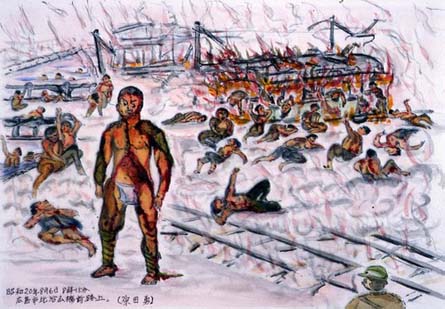
1,700 m from the hypocenter, Hijiyama Bridge
August 6, 1945
Isamu Harada
(14 at the time of the bombing, 71 when he drew this picture)
Explanation in picture; A Hijiyama-bound streetcar was stopped and afire. The shell was half smashed. Bodies charred completely black hung from the windows or lay where they had been thrown on the road. Every person on that streetcar had died instantly.
A man who resembled a mythical temple guardian slowly dragged his feet in my direction. He still wore a loincloth and ragged gaiters on one leg. His clothes had burned into a few tatters, leaving him virtually naked. One eye had popped out of his swollen, bright red face.
2. Many who entered the river to escape the fire were swept away

1,400m from the hypocenter / Riverside in back of Shukkeien Garden
Around 9 a.m. on August 6, 1945
Yoko Suga
(14 at the time of the bombing, 43 when she drew this picture)
Explanation in picture; Many people ran from the raging fire and managed to reach the riverbank only to run out of strength and sink to the ground. Some died, writhing in pain right in front of me. Those who were still alive walked toward the bank and into the river.
Uncountable numbers drowned as they were swept away. Still, they kept walking into the water to escape the flames.
3. Unable to save the girl's mother, I joined my hands in prayer.
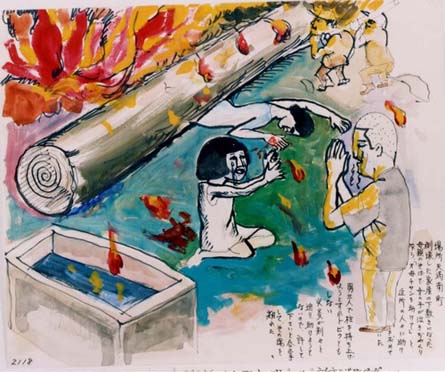
1,300m from the hypocenter, Tenma-cho(Nishi-ku)
August 6, 1945
Akira Onogi
(15 at time of bombing, 45 at time of drawing)
Explanation in picture; Her mother trapped under their collapsed house, a young girl was sobbing violently. She yelled to her neighbors, “Save my mother.” Three men could not have budged that beam. Flames were moving in quickly. There was no way to save her. I joined my hands in prayer. “Please forgive me,” I said, and left.
4. Mother unable to save her child trapped under the building
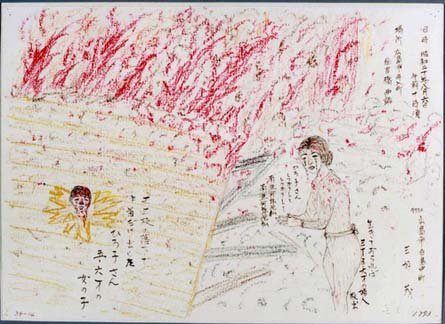
1,400m from the hypocenter, west end of Sumiyoshi Bridge (Funairi-hon-machi, Naka-ku)
August 6, 1945, around 10 a.m.
Shigeru Miyoshi
(40 at time of bombing, 70 at time of drawing)
Explanation in picture; If she were alive now, she would be a woman of 35 or 36. “Hiroko, don't give up, be strong. Namu Amida Butsu, Namu Amida Butsu.”
Hiroko... Only her head stuck out from under the fallen ceiling. A girl of 5 or 6.
5. Children trapped under their school
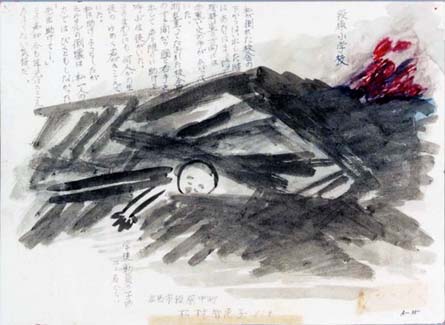
1,800m from the hypocenter, Dambara Elementary School (Matoba 2-choume,Minami-ku)
August 6, 1945
Chieko Matsumura
(33 at time of bombing, 62 at time of drawing)
Explanation in picture; There were about 20 mobilized students. When I crawled out of the fallen school building, everything around me was dark. Red-black flames were licking up near the science room. From a gap in the pile of broken school building, a student stuck his head and right arm out. He was calling for help at the top of his lungs. Around him I could hear other students groaning. I tried to help, but the mortar just crumbled. I couldn't do a thing alone. I can still hear those voices calling, “Teacher, help.” I can hardly bear it.
6. Mother unable to save her child trapped under the building
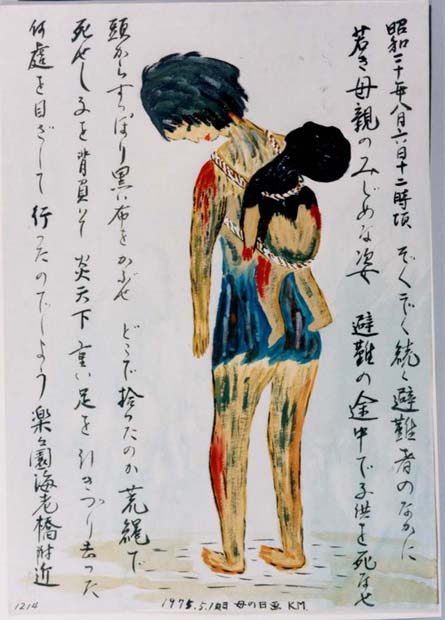
10km from the hypocenter, near Kairo Bridge in Rakurakuen,Itsukaichi-cho (Rakurakuen, Saeki-ku)
August 6, 1945, around noon
Kazuno Mae
(26 at time of bombing, 56 at time of drawing)
Explanation in picture; Among the crowds of injured filing by, I saw a pathetic young mother. Her child had died as they fled.
Now, It was covered from head to toe in blackened cloth.Where did she get the straw rope she used to tie it to her back? She trudged away under the scorching sun. I wonder where she was going.
7. A mother who burned up trying to shelter her two children

1,200m from the hypocenter, near Tenma-cho (Tenma-cho, Nishi-ku)
August 7, 1945
Kazuo Akiyama
(34 at time of bombing, 64 at time of drawing)
Explanation in picture; A mother and her two children had been swallowed by the flames they were trying to flee. She had dropped forward on the ground, pulling them beneath her, and that is how they died. The children's fingers had dug deeply into their mother's skin.
8. A girl who died while asking for water near Tsurumi Bridge
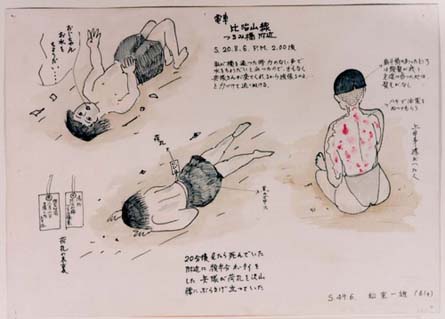
1,700m from the hypocenter, Hijiyama Streetcar Line, near Tsurumi Bridge (Hijiyama-hon-machi, Minami-ku)
August 6, 1945, around 2:00 pm
Kazuo Matsumuro
(32 at time of bombing, 61 at time of drawing)
Explanation in picture; When I passed near her, she feebly asked for water. “Don't give up, soldiers will be here soon,” I said encouragingly, as I walked on by.
When I saw her 20 minutes later, she was dead.
Nearby stood a soldier whose face was half bandaged. Lots of body tags hung from his waist.
Front and back of a body tag
Location: Tsurumi Bridge East, Hijiyama Line
Estimated time: August 6, around 2 p.m. about 5 years old
9. A mother setting out to cremate her child

800 m from the hypocenter, near Takeya-cho (Takeya-cho, Naka-ku)
August 7, 1945, around 8:00 a.m.
Kazuo Matsumuro
(32 at time of bombing, 61 at time of drawing)
“Where shall I burn the body of my dead child?” White maggots crawled in the face burns of the child she carried on her back.She probably picked up the metal helmet as a receptacle for her child's bones.
She had to walk quite a distance to find combustable material for the fire.
10. Corpse after carbonized corpse in and around the streetcar
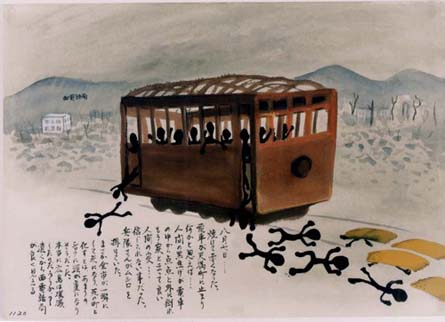
1,300 m from the hypocenter, Tenma-cho
August 7, 1945
Toshiko Kihara
(17 at the time of the bombing, 47 when she drew this picture)
Explanation in picture; My eye was caught by a fire-reddened streetcar stopped at Tenma-cho.
Lined up inside and strewn around the outside were black-burned people now turned to charcoal--human charcoal.
I could not believe my eyes as I watched soldiers cover them with straw mats.
How could an entire city turn to charcoal and ashes in an instant? The shock made me feel lightheaded.
11. Corpses of passengers still sitting in their seats
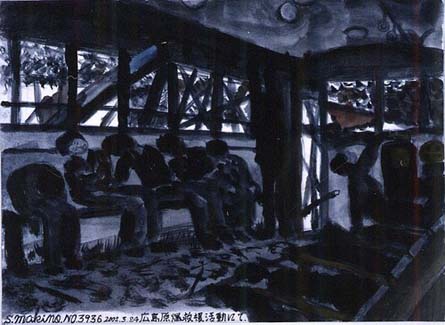
Distance from hypocenter unknown
August 7, 1945
Shunsuke Makino
(29 at the time of the bombing, 86 when he drew this picture)
Explanation in picture; Looking into a streetcar that had been blown off the track, I saw mostly seated corpses. One, however, was hanging from the hand-strap it still clutched.
12. People who died crowded around a fire cistern
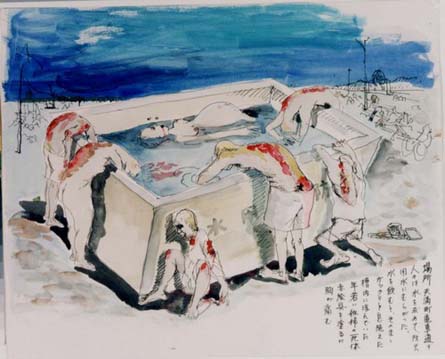
1,300 m from the hypocenter, Tenma-cho Streetcar road
Akira Onogi
(15 at the time of the bombing, 45 when he drew this picture)
Explanation in picture; People had crowded around the fire cistern to get water, but after they drank, they died on the spot. The corpse of a young pregnant woman floated in the water. My chest hurts as I apply the red paint.
13. Mobilized students who had died in a pile.Mothers calling the names of their children.

600m from the hypocenter, Shin-ohashi Bridge (Nishi-heiwa-ohashi Bridge, Naka-ku)
August 7, 1945, around 9:00 a.m.
Sueko Sumimoto
(37 at time of bombing, 67 at time of drawing)
Explanation in picture; This area was full of mobilized students. The riverbank and the river were full of dead students about 13 or 14 years old, all about the same height. They floated downstream, bobbing up and slipping under the surface, just like floating daikon radishes.
Children lay in a tumble, piled on each step of the stairway leading down to the river. Their innocent faces smote my heart.
A mother screaming the name of her child
14. Teachers and students of Municipal Girls School in a cistern
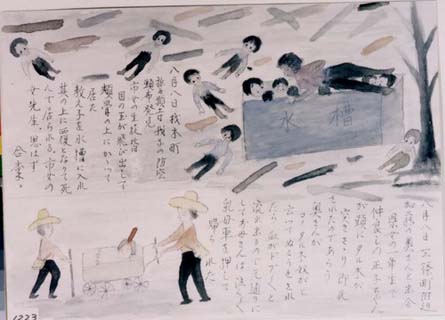
400m from the hypocenter, Zaimoku-cho (Nakajima-cho, Naka-ku)
August 8, 1945
Tokiko Kuwamoto
(41 at time of bombing, 70 at time of drawing)
Explanation in picture; August 8, Zaimoku-cho
I found my child's air-raid hood at Senganji Temple. The eyeballs of the students of Municipal Girls Schools had popped out and hung on their cheekbones.
A female teacher had lifted her students into the cistern and covered them with her body. Instinctively, I joined my hands in prayer.
August 8, near Misasa-machi
I met Mrs. Kato. She said that a piece of barrel wood had hit Masako-chan (a first-year student at Prefectural Girls School and a good friend of my daughter's) in the head and probably killed her instantly. When she tried to pull it out, shouting “Damned piece of wood!” her daughter's blood poured out, so she stuck it back in, placed her on a cart,andpushed it home, crying all the way.
15. Barely breathing victims who took refuge in a burnt but standing building
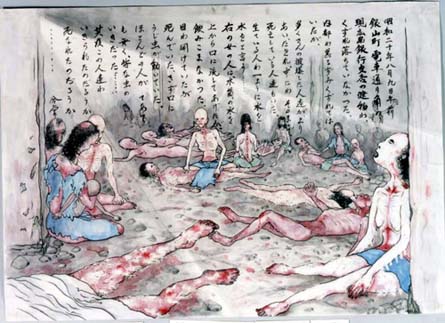
1,210m from the hypocenter / Shimoyanagi-cho (now, Kanayama-cho, Naka-ku)
Morning, August 9, 1945
Shoichi Furukawa
(32 at the time of the bombing, 62 when he drew this picture)
Explanation in picture; There were lots of people lying right next to each other. Some were already dead. Those still alive were calling, “Water, water.” I poured some water from my canteen into the mouth of the woman on the right, but she didn't drink it. Her eyes were open but she was dead. Maggots were moving in her wounds.
Nearly all were barely breathing and got no treatment at all. Wondering if any of these people lived, I put my hands together in prayer.
16. Victims lined up in two rows on the tracks
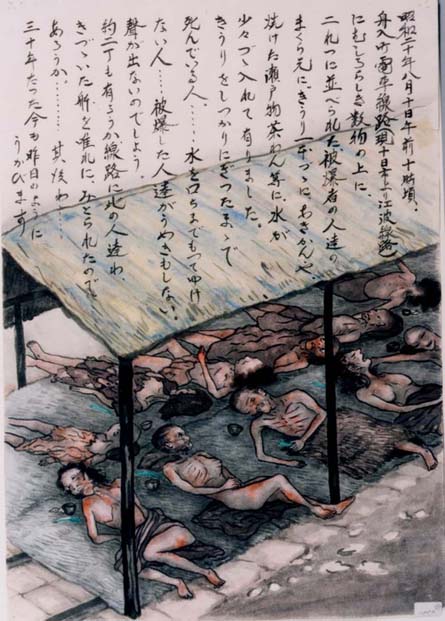
1,100 m from the hypocenter, Funairi-machi
August 10, 1945, around 10:00 a.m.
Shoichi Furukawa
(32 at the time of the bombing, 62 when he drew this picture)
Explanation in picture; Victims were lying in two rows on straw mats laid on the streetcar tracks at Funairi-machi. A cucumber had been placed next to each of their heads, along with a little water in an empty can or burnt ceramic cup. Some had died firmly grasping their cucumber. Some could not even get the water to their mouths.
These victims did not even groan, probably because their voice was gone.
Did any relative take care of the 20 or so injured persons lying on the tracks? What happened to them?
Thirty years later, I can see that scene as if it were yesterday.
17. Pulling the enormous number of corpses floating in the river into boats
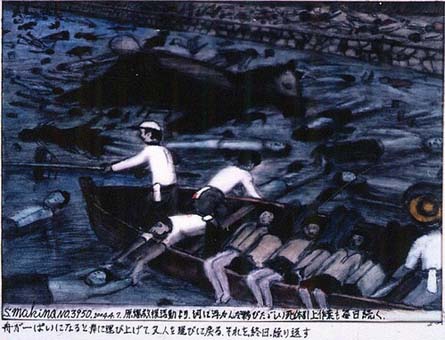
Drawing / Shunsuke Makino
18. Numerous swollen corpses with peeling skin floated on the surface of the river.
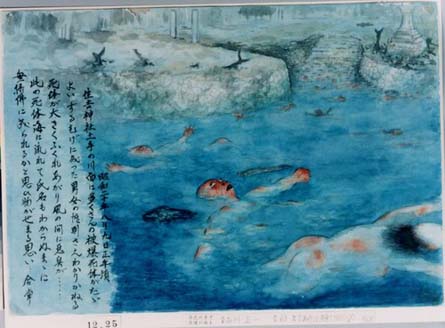
1,300m from the hypocenter/Near Sumiyoshi Shrine
Around noon on August 9, 1945
Shoichi Furukawa (32 at the time of the bombing, 62 when he drew this picture)
Explanation in picture; Many corpses floated in the river off the Sumiyoshi Shrine riverbank. The skin had peeled off bodies so swollen that their gender was unclear. A stench wafted in the air. My chest felt heavy knowing that they would be swept out to sea, their names unknown, their deaths unattended. I put my hands together in prayer.
19. Charred corpses were carried one after another from the burnt ruins and cremated.
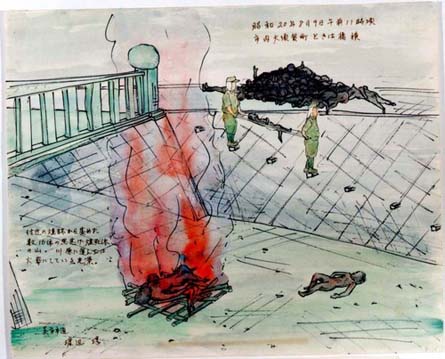
1,550m from the hypocenter Osuga-cho
Around 11:00 pm, August 9, 1945
Jun Watanabe
(Age 16 at time of bombing, 45 at time of drawing)
20. Cremating my own child

Distance from hypocenter unknown
August 7, 1945, evening
Tamaki Ishifuro
(35 at time of bombing, 65 at time of drawing)
Explanation in picture; I cremated my oldest daughter Naoko (3). The tears flowed without stopping.
“You go first, I'll follow you!” I joined my hands in prayer. My second son Katumi (9) was still missing. I prayed that he had fled safely somewhere.
As she burned, the oil in her body gradually flowed out. A huge amount, what a healthy child! So piteous. I couldn't stand to watch, I though I would go crazy. How could this be the real world? It was hell “ I have continued to live for 30 years feeling guilty toward my two dead children. Forgive me, I didn't keep my promise, a parent's responsibility. (I didn't have the courage.)”



















